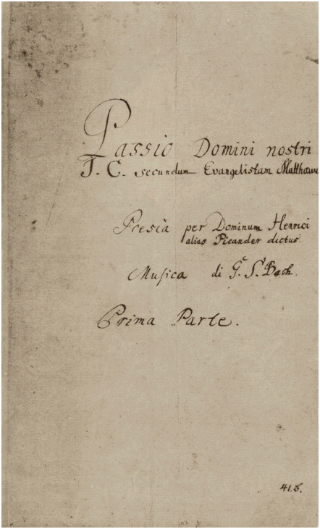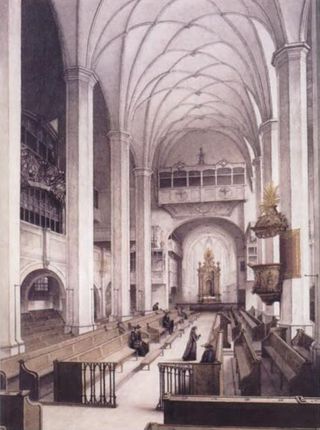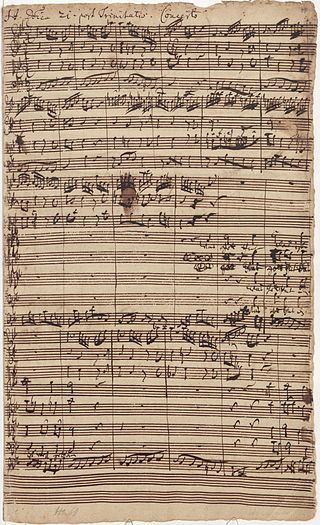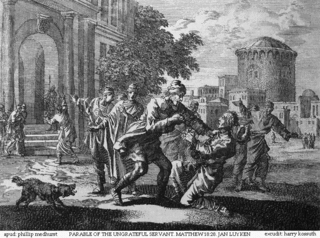
Johann Sebastian Bach composed the church cantata Mein Herze schwimmt im BlutBWV 199 in Weimar between 1712 and 1713, and performed it on the eleventh Sunday after Trinity, 12 August 1714. It is a solo cantata for soprano.

The St Matthew Passion, BWV 244, is a Passion, a sacred oratorio written by Johann Sebastian Bach in 1727 for solo voices, double choir and double orchestra, with libretto by Picander. It sets the 26th and 27th chapters of the Gospel of Matthew to music, with interspersed chorales and arias. It is widely regarded as one of the masterpieces of Baroque sacred music. The original Latin title Passio Domini nostri J.C. secundum Evangelistam Matthæum translates to "The Passion of our Lord Jesus Christ according to the Evangelist Matthew".

Johann Sebastian Bach composed the church cantata (Bach) Wo soll ich fliehen hin, BWV 5, in Leipzig for the 19th Sunday after Trinity and first performed it on 15 October 1724. It is based on the penitential hymn "Wo soll ich fliehen hin" by Johann Heermann.

Johann Sebastian Bach composed the church cantata Herz und Mund und Tat und Leben, BWV 147 in 1723 during his first year as Thomaskantor, the director of church music in Leipzig. His cantata is part of his first cantata cycle there and was written for the Marian feast of the Visitation on 2 July, which commemorates Mary's visit to Elizabeth as narrated in the Gospel of Luke in the prescribed reading for the feast day. Bach based the music on his earlier cantata BWV 147a, written originally in Weimar in 1716 for Advent. He expanded the Advent cantata in six movements to ten movements in two parts in the new work. While the text of the Advent cantata was written by the Weimar court poet Salomo Franck, the librettist of the adapted version who added several recitatives is anonymous.
Der Friede sei mit dir, BWV 158, is one of the shortest of the cantatas by Johann Sebastian Bach and features a bass soloist. It survives as a cantata for the third day of Easter but might be a fragment of a work originally written for Purification. Given this background, and the fact that it was copied by Christian Friedrich Penzel, one of Bach's last students, there is a confusing variety of proposed composition dates. It may date back to Bach's Weimar period, although a date as late as 1735 has been suggested.

Johann Sebastian Bach composed the church cantata Ich hatte viel Bekümmernis, BWV 21 in Weimar, possibly in 1713, partly even earlier. He used it in 1714 and later for the third Sunday after Trinity of the liturgical year. The work marks a transition between motet style on biblical and hymn text to operatic recitatives and arias on contemporary poetry. Bach catalogued the work as e per ogni tempo, indicating that due to its general theme, the cantata is suited for any occasion.

Johann Sebastian Bach composed the church cantata Bereitet die Wege, bereitet die Bahn, BWV 132, in Weimar in 1715 for the fourth Sunday of Advent and led the first performance on 22 December 1715.

"Wo soll ich fliehen hin" is a hymn in seven stanzas by the German Baroque poet, Lutheran minister and hymn-writer Johann Heermann. It was first published in 1630 during the Thirty Years' War. It is a penitential hymn for Lent.

Johann Sebastian Bach composed the church cantata Wer nur den lieben Gott läßt walten, BWV 93, in Leipzig for the fifth Sunday after Trinity and first performed it on 9 July 1724. It is part of his chorale cantata cycle, the second cantata cycle he started after being appointed Thomaskantor in 1723.

Erforsche mich, Gott, und erfahre mein Herz, BWV 136 is a church cantata by Johann Sebastian Bach. Bach composed the cantata in 1723 in Leipzig to be used for the eighth Sunday after Trinity. He led the first performance on 18 July 1723.

Johann Sebastian Bach composed the church cantata Ach! ich sehe, itzt, da ich zur Hochzeit gehe, BWV 162, in Weimar for the 20th Sunday after Trinity and first performed it in 1715 or 1716.

Wachet! betet! betet! wachet! is the title of two church cantatas by Johann Sebastian Bach. He composed a first version, BWV 70a, in Weimar for the second Sunday in Advent of 1716 and expanded it in 1723 in Leipzig to BWV 70, a cantata in two parts for the 26th Sunday after Trinity.

Schau, lieber Gott, wie meine Feind, BWV 153, is a church cantata by Johann Sebastian Bach. He composed it in Leipzig for the Sunday after New Year's Day and first performed it on 2 January 1724.

Mein liebster Jesus ist verloren, BWV 154, is a church cantata by Johann Sebastian Bach. He composed it for the first Sunday after Epiphany and first performed it in Leipzig on 9 January 1724.

Johann Sebastian Bach composed the church cantata Barmherziges Herze der ewigen Liebe, BWV 185 in Weimar for the fourth Sunday after Trinity and first performed it on 14 July 1715.

Johann Sebastian Bach composed the church cantata Was Gott tut, das ist wohlgetan, BWV 98, in Leipzig for the 21st Sunday after Trinity and first performed it on 10 November 1726.

Johann Sebastian Bach composed the church cantata Was soll ich aus dir machen, Ephraim, BWV 89, in Leipzig for the 22nd Sunday after Trinity and first performed it on 24 October 1723.

Meinen Jesum laß ich nicht, BWV 124, is a church cantata written by Johann Sebastian Bach. He composed the chorale cantata in Leipzig for the first Sunday after the Epiphany and first performed it on 7 January 1725. It is based on the hymn "Meinen Jesum laß ich nicht" by Christian Keymann.
In allen meinen Taten, BWV 97, is a church cantata by Johann Sebastian Bach. He composed the chorale cantata in Leipzig in 1734 for an unspecified occasion. The text consists of the unchanged words of the hymn by Paul Fleming (1642).

Ich lasse dich nicht, du segnest mich denn, BWV 157, is a church cantata by Johann Sebastian Bach. He composed it in Leipzig in 1726/27 to a libretto by Picander. The first known performance was on 6 February 1727 during a memorial service for Johann Christoph von Ponickau in Pomßen near Leipzig. The work was later assigned to the feast of the Purification celebrated on 2 February.











